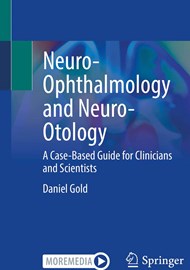As Daniel Gold points out in his preface, the idea for this title was borne from the observation that, despite the considerable overlap between the fields of neuro-ophthalmology and vestibular neurology, there is no single text that marries these two subspecialities. Neuro-Ophthalmology and Neuro-Otology - A Case-Based Guide for Clinicians and Scientists is the perfect solution to this void.
Supplemented by links to Dr Gold’s online NOVEL (Neuro-Ophthalmology Virtual Education Library), which is currently free to access, this book can be viewed as a ‘go-to’ text for anyone dealing with the medical aspects, as opposed to surgical management, of complex neuro-otological patients. The text is designed to flow logically in case the reader wishes to read it from cover to cover, but also, perhaps more usefully, can be delved into as required as the chapters are titled according to presenting symptoms. The following chapter titles are given:
- Preparing for the Exam (equipment required for examination)
- Disorders of the Pupils, Eyelids, and Orbits
- Loss of Vision and Other Visual Symptoms
- Motility and Ocular Motor Disorders
- Oscillopsia, Nystagmus and Other Abnormal Movements
- Vestibular Disorders
- Pediatric Clinical Pearls
The opening chapter gives a list of must-have pieces of equipment for the clinic and/or the individual clinicians’ purchase, which is potentially useful to those new to the neuro-otology field. Subsequent chapters are fronted by the relevant anatomy and physiology, an approach to history-taking and examination and then systematically cover common presentations of the relevant conditions using case-based examples. The cases are all complemented by a mixture of anatomical drawings, labelled photographs to illustrate the relevant surface anatomy and neuro-radiological imaging. Anyone purchasing this book should consider purchasing the e-book as, not only is this of course more environmentally-friendly, but another user-friendly highlight is the existence of hyperlinks to the various relevant tables, videos and other text within the book that the reader may logically wish to read next.
Dr Gold’s affability comes across in his casual, informal approach (‘Key questions to ask: ‘Do not miss this!’, ‘If you can only remember one thing…’ and ‘Read these books!’) and makes this text incredibly readable, in my opinion. It is obvious he has written this with teaching and education of trainees and colleagues in mind.
Text plus points:
- Clear illustrations and self-explanatory figure legends.
- Hyperlinks given to videos illustrating hundreds of different eye movement disorders.
- Logical flow of the text, designed with the clinician in mind, allowing them to ‘dip in’ as required to the relevant section based on the patient’s presenting symptom(s).
- Casual language used in places gives the impression of the author sitting in the room with the examining clinician, chatting through the case in real time - a psychological plus point!
- A huge amount of complex neurology is covered in maximum detail.
Any pitfalls?
- There are over 100 pages at the front of the 476-page text detailing the legends to the videos given in the online NOVEL collection. I wonder if the legends would be better placed within the body of the text of the relevant cases.
- The ‘Americanisms’ of the book require some adaptation for a UK-based clinician, e.g. OD is the abbreviation for ‘oculus dexter’ which is Latin for ‘right eye’ and OS is an abbreviation for ‘oculus sinister’ which is Latin for ‘left eye’, whereas in the UK we simply call a spade a spade and use the terms ‘right eye’ and ‘left eye’!
Summary
This book is a wealth of information about our niche, often overlooked, subspecialty delivered in this one comprehensive text. Daniel Gold is in a unique position, sitting firmly in both vestibular neurology and neuro-ophthalmology camps, and his expansive clinical knowledge in this regard is shared with clarity in this equally unique text. This book should sit proudly on the shelf (or e-shelf!) of all audiovestibular trainees like me and would also suit clinicians in multiple other allied specialties. I have waited for some time for a case-based book such as this which covers the varied presentations within vestibular neurology, and the text has not failed to deliver. I look forward to a UK-based equivalent text to hopefully follow suit as, from my own perspective as a trainee, case-based learning in textbook form is second only to examining these fascinating patients in real life.




